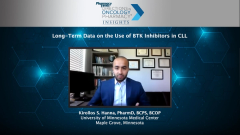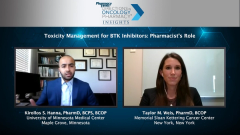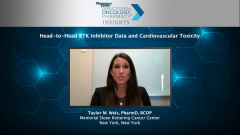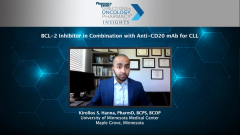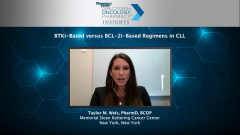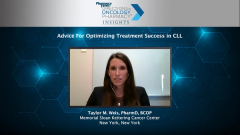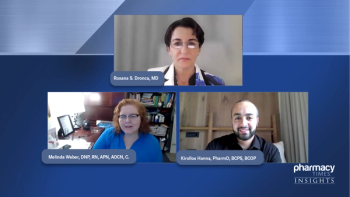
BCL2 Inhibitor in Combination With Anti-CD20 mAb for CLL
Kirollos S. Hanna, PharmD, BCPS, BCOP, discusses data on a BCL2 inhibitor in combination with anti-CD20 monoclonal antibodies in the treatment of CLL.
Episodes in this series

Kirollos S. Hanna, PharmD, BCPS, BCOP: With all these combinations, it seems like the data with BTK [Bruton tyrosine kinase] combining with an anti-CD20 are somewhat iffy right now, and that’s why it’s usually a plus or minus. Now, transitioning and going to the BCL2 [inhibitor] route and combining venetoclax, which is our only FDA-approved BCL2, with other anti-CD20 monoclonal antibodies. Thus, I think there are 2 notable trials here. There’s CLL14 and MURANO, and these are really exciting trials because one was looking at treatment-naive patients with CLL and one was looking at the relapsed/ refractory patient population. One combines venetoclax with obinutuzumab, and one combines venetoclax with rituximab. It’s really exciting because the approach to these studies is around this whole MRD [minimal residual disease] negativity concept, or undetectable minimal residual disease, and if we can get patients to that, or even if we don’t, could we treat them for a finite period, 1 year, 2 years, and then get them off a therapy? We know that with BTK inhibitors, these patients are on therapy indefinitely until progression, or unacceptable toxicity, or death. Ultimately, one notable thing we saw that was published from CLL14 and MURANO, as the years go on, we’re seeing more and more positive end points showing that those who reach MRD negativity, or even those in the entire intent-to-treat population, it still favored targeting BCL2 in combination with an anti-CD20, whether it was obinutuzumab or rituximab. I believe from CLL14 now, we have 4-year data, and the PFS [progression-free survival] rate there was 74% favoring the venetoclax, obinutuzumab arm, some call it Ven-G for the brand name [Gazyva], versus chlorambucil, obinutuzumab.
Now, again, this is going to go back to my argument with BTK and the RESONATE trial, for example. It was ibrutinib versus chlorambucil. Here we have venetoclax in combination with obinutuzumab versus chlorambucil and obinutuzumab, which at the time, could have been a treatment option, but chemoimmunotherapy is not really how we treat most of our patients now. What does this mean in terms of efficacy outcomes for our patients? It’s really exciting, and very important that as we continue to see these long-term outcomes, 4, 5, 6 years, that we see the sustained PFS or even OS [overall survival] benefit. It’s important to note that from CLL14, for example, we have not yet seen a statistically significant overall survival benefit, so in terms of the overall survival, there’s no difference. When comparing Ven-O [venetoclax, obinutuzumab] versus chlorambucil [and obinutuzumab], the 4-year overall survival is still about 85% versus 83%. Thus, there has not yet been enough death events to deem one group more significant than the other. But this will come with time. I love when you look at the Kaplan-Meier curve between these 2, and I encourage all of our participants to look at it, there is no crossing by any means between the 2 regimens in venetoclax-O [obinutuzumab] or venetoclax-R [rituximab] versus the comparator regimens. It’s very notable, especially these trials, in front line they only treated patients for 1 year then got them off of therapy. Treatment-free. The other trial looked at patients on 2 years of therapy, and then are seeing these benefits sustained throughout.
In terms of safety events, I think the biggest thing to note is going to be managing tumor lysis. With BCL2 inhibition, tumor lysis is always going to be a toxicity of interest, especially in the CLL population. Some patients, I think, at presentation could have bulky disease, so it’s really important for us to risk stratify these patients as low, moderate, or high risk, and based on the risk stratification, we have to provide antihyperuricemics, potentially with something like allopurinol, to ensure that we are keeping that uric acid level. Also, evaluating their CMPs [comprehensive metabolic panels], for those high-risk patients, you might need to hospitalize them, unless you have the infrastructure to monitor them very closely in the outpatient setting. Aggressive hydration, aggressive fluids. All these things are what we are going to stress to our patients, especially during the ramp-up of venetoclax.
One notable thing we have to talk about though in terms of safety, both in CLL14 and MURANO, if you follow the debulking algorithm that they have, one started venetoclax first and then the anti-CD20, and the other started the anti-CD20 first then put venetoclax on board. But in both, it was ultimately a 5-week ramp-up of venetoclax, and both of these clinical trials had 0% incidence of clinical TLS [tumor lysis syndrome]. Now, there was some laboratory-reported TLS, which is not an oncologic emergency. But if you follow the ramp-up, risk stratify your patient, do so accordingly, it is very uncommon that you’re going to end up having clinical TLS, which would require hospitalization, aggressive intervention, etc. Thus, it’s very exciting that now with CLL we are beginning to see these finite treatment durations or intervals or approaches. Again, we’re dealing with a completely different type of regimen, different [adverse] effect profiles. I think with both BTKs and BCL2s you’re going to deal with neutropenia across the board, and you’re going to have to evaluate your patient and support your patient accordingly. But these are all going to be important things we have to keep in mind.
In terms of MRD negativity, this is a new topic of interest that I think many of us don’t know what to do with yet. We certainly know that if we can reach MRD negativity—aka undetectable minimal residual disease, it’s abbreviated differently throughout the literature—it’s demonstrating that patients are doing better, but we don’t yet have a home run outcome in terms of MRD negativity. The way I think about it right now, it’s kind of like PD-L1 expression; PD-L1 expression is not always about PD-L1 positive, nor is it about having totally MRD negative. There are a lot of factors, but I think most of the clinical trials have shown that if you can reach MRD negativity, we can get patients off of therapy. But you can still get your patient off of therapy, even if they are MRD positive. There are all these different things, because you can still have a CR, a complete response, but be MRD positive, and vice versa. You can be MRD negative, but not have a CR.
Transcript edited for clarity.
Newsletter
Stay informed on drug updates, treatment guidelines, and pharmacy practice trends—subscribe to Pharmacy Times for weekly clinical insights.



